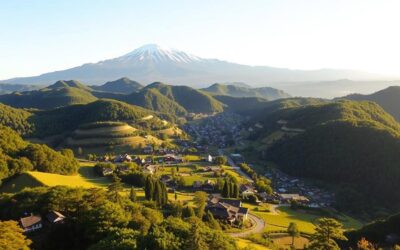How Japan’s ‘Blue Zones’ Are Redefining Healthy Aging in 2024

Okinawa, Japan, holds the title for the world’s highest life expectancy among women. This fact highlights the role of Japan’s Blue Zones in changing our views on healthy aging in 2024. These areas are known for their large number of people living past 100 years. They teach us valuable lessons about living longer that can help everyone.
Looking at Japan’s Blue Zones, especially Okinawa, shows us the benefits of eating mostly plants, having close social connections, and living with purpose. For example, following the ikigai philosophy is key. Also, making cities more friendly for all ages can help communities thrive. Let’s discover what makes Japan’s Blue Zones special for a better way to stay healthy as we age.
Key Takeaways
- Okinawa is recognized as a Blue Zone with the highest life expectancy among women.
- Key features of Blue Zones include pedestrian-friendly designs and accessible public spaces.
- Residents practice Hara Hachi Bu, promoting mindful eating habits.
- The Okinawan diet is rich in nutrient-dense foods, contributing to their longevity.
- Social connections and a sense of purpose significantly impact the well-being of Okinawans.
Introduction to Blue Zones and Their Global Importance
Blue Zones are special areas where people live much longer, healthier lives. Dan Buettner found these zones in places like Okinawa (Japan), Sardinia (Italy), Loma Linda (USA), Ikaria (Greece), and Nicoya (Costa Rica). These areas show us important lifestyle habits for longer life. These habits could help the whole world as our populations get older.
In Blue Zones, unique cultural habits and the environment help people age well. Okinawa’s residents, for example, share strong community bonds and a deep sense of purpose. These key elements, known as the Power 9, include eating lots of plants, drinking alcohol in moderation, and staying active. These habits make people and their communities healthier.
The lessons from Blue Zones have led to the creation of the Blue Zones Project. This project makes changes in the environment and policy to encourage healthy living. It’s working well in the United States, where communities are adopting these healthy strategies. By learning from Blue Zones, we can all use global wellness rituals for better aging. This benefits individuals and communities all over the world.
Understanding Japan’s Blue Zones
Okinawa, Japan, is a remarkable example of a Blue Zone with very long-lived residents. This area has a lot of people over 100 years old, especially women. They often live more than ten years longer than the average American. Looking at Okinawans and how they live gives us great tips for healthy aging.
Overview of Okinawa and Its Unique Longevity
Okinawa’s secret to a long life includes many cultural and social factors. The people have a strong sense of purpose. This keeps them active and happy. They naturally include physical activities like gardening and walking in their daily life. This improves both their body and mind.
Furthermore, having close social networks is key. Through moai groups, they form tight-knit bonds with neighbors and friends. Feeling connected and supported plays a big part in their long life spans.
The Role of Diet in Okinawa’s Healthy Aging
Okinawans eat a healthy diet that includes many traditional Japanese foods. They prefer veggies to meat and eat plenty of local superfoods. Foods like purple sweet potatoes, bitter melon, and seaweed are full of nutrients but low in calories. This kind of diet helps them live longer without health issues.
They also follow “hara hachi bu,” which means they stop eating when they’re 80% full. This stops them from overeating and keeps their diet balanced. It’s a way to ensure they eat well but also enjoy their food.
In conclusion, Okinawa’s secret to aging well includes a healthy diet, community support, and local superfoods. All of these elements together make Okinawa a great place for living a long, healthy life. This approach to wellness and community is something we can all learn from.
Longevity Secrets of Japan’s Blue Zones
Exploring Okinawa’s centenarian habits gives us insight into their long-life secrets. These habits mix lifestyle choices that improve both mind and body health, helping people live a vibrant life into old age. By looking into these practices, we learn that small changes in our routines can lead to healthier aging.
Centenarian Habits That Promote Wellness
Okinawa’s elders focus on habits that boost well-being. They eat a plant-based diet with lots of fruits, veggies, and beans. Foods like purple sweet potatoes and goya are key in their diet. This way of eating cuts down on meat and keeps calories low but nutrition high. They also follow hara hachi bu, eating until they’re 80% full to stay at a healthy weight and lower the risk of sickness.
Staying active is key to their lifestyle, not through gym workouts, but through natural activities like gardening and walking. Even practicing karate keeps them strong and balanced. They also build strong emotional bonds through friendships and family, which is crucial for a long, happy life.
The Cultural Significance of ‘Ikigai’ in Aging Gracefully
The concept of ikigai, or “reason to live,” is vital for graceful aging in Okinawa. It’s about finding purpose in what you love and do. Having a clear purpose is good for mental health and drives people to pursue their goals. Also, the support networks called moai provide crucial social and emotional support, making their community stronger.
Okinawans show that living well involves making wise choices about wellness, community, and purpose. Embracing these principles can lead to a better quality of life and well-being as we age.
The Impact of Urban Design on Healthy Aging
Urban design is key in making communities friendly for older people. It helps improve their life quality by focusing on easy access, social activities, and exercise. Japan’s Blue Zones are great examples of how smart city planning supports health and long life.
Age-Friendly Neighborhood Features in Blue Zones
In age-friendly areas, good urban design includes things like accessible homes, shared spaces, and greenery. Singapore, for example, has made green spaces part of daily life with its large Park Connector Network. This makes it easier for people to move and meet others. Also, the Kampung Admiralty project shows how vertical villages can offer health care and community services close by for the elderly.
Walkability and Social Interaction in Urban Areas
Walking-friendly places help older adults stay active. In Albert Lea, Minnesota, adding sidewalks and walking paths has helped people live longer. These changes help residents connect more, making the community stronger. Plus, cities with bike paths, like Paris, see more people cycling. This gives seniors more ways to stay involved in their communities.

Adding elements that boost social ties and exercise, urban design can greatly aid in aging well. Stories from Blue Zones worldwide show how vital it is to make environments that care for older adults’ health and happiness. This proves that thoughtful urban planning has a big impact on how long people live.
Nutrition and the Blue Zones Diet 2024
The Okinawan diet shows us the impact of our food on health and long life. In 2024, more people are noticing the blue zones diet because it focuses on foods full of nutrients that help us age better. By looking at Okinawan superfoods, we learn about their health perks and their place in the science of aging.
Traditional Okinawa Superfoods and Their Benefits
The Okinawan diet is packed with nutrients and a variety of foods, mainly including:
- Purple sweet potatoes – A key food loaded with antioxidants and vitamins.
- Soya beans – Great for protein and fiber.
- Seaweed – Rich in minerals and omega-3 fats.
This way of eating is low in calories but high in vital nutrients. Okinawans prefer foods grown locally and in season, like fish and lean meats. They also practice “hara hachi bu,” eating until they’re 80% full. This helps avoid eating too much and supports good digestion.
Comparing the Blue Zones Diet to Modern Diet Trends
The blue zones diet 2024 and current diets are quite different. The blue zones diet favors:
- Plant foods like fruits, veggies, grains, legumes, nuts, and seeds.
- A daily handful of nuts for good fats.
- Whole grains instead of processed ones for better nutrition.
- Beans, soy, or lentils daily for protein variety.
Modern diets often look for quick fixes or rely on processed food. The blue zones diet, however, suggests eating lean proteins, such as fish. It suggests red meat only five times a month. This diet, along with strong social connections in Okinawa, shows that community and support boost our lifespan and happiness.
Healthy Aging 2024: Insights from Japanese Practices
In 2024, looking at Japanese traditions teaches us a lot about aging well. Okinawa stands out for its many centenarians. They show us how keeping active and staying connected is key to a long, healthy life.
Physical Activity and Its Role in Longevity
Japan has a lot of older adults, making up about a third of its people. This situation highlights how vital physical activity is for staying healthy as we age. Older folks tend to enjoy gardening or helping out in their neighborhoods. These activities not only keep them fit but also help them make friends, which is good for their mood.
Mental and Emotional Well-Being Strategies
Japanese culture has a positive way of looking at getting older. It values everyone’s role in society and the strength of community bonds. The idea of Ikigai, meaning having a life purpose, is really important for feeling good mentally. Being part of social circles, or moais, helps build a strong support network. These mental well-being strategies are something we can all learn from to improve how we feel and connect with others.

Aging Population Solutions Inspired by Japan’s Blue Zones
Japan’s Blue Zones show us urban planning can help us live longer. In areas like Okinawa, many people live past 100. This has sparked interest in using their methods elsewhere. By making cities friendlier for older people, we can improve their health and happiness.
Policy Implications for Urban Planning
To help older people stay healthy, cities need smart design. This includes parks, easy transport, and houses designed for seniors. Making neighborhoods that are easy to walk around and close to doctors helps too. This makes it easier for seniors to meet people and stay involved in the community.
Community Engagement and Support Systems
Helping seniors feel part of the community is key. Things like volunteer work and programs that mix young and old people help. These activities help older folks share their knowledge and stay self-reliant. By doing this, we make their lives better, just like in Japan’s Blue Zones.
Redefining Aging Through Climate-Resilient Practices
In Japan’s Blue Zones, a strong link between the environment and health shows how important climate-resilient aging is. These areas focus on sustainability and wellness for the elderly. By focusing on healthy environments, we help people age well and keep a high quality of life.
The Influence of Environment on Health in Blue Zones
Okinawa’s urban design plays a key role in physical and mental health. Daily life includes activities like walking and gardening, thanks to easy-to-reach green places. This improves our health and supports climate-resilient aging through sustainable and nature-friendly habits.
Singapore shows how smart urban planning can make communities better. Tax breaks for living with different generations and better public transport create welcoming places for elderly people. This helps them live longer, proving that a community-focused setting has a good effect.
Having close friends and family is very important in Blue Zones. These relationships help older people feel less lonely. They also practice mindfulness and manage stress well, which improves mental health. Learning from these areas shows us that sustainable living is key to aging well.
Global Wellness Rituals Influenced by Japan’s Blue Zones
Japan’s Blue Zones show us smart ways to live longer and healthier lives. They show cultural habits that inspire wellness worldwide. Seeing these habits helps us see the value in aging with a purpose.
These methods boost health and help people feel like they belong. They also give everyone a sense of purpose.
How Other Cultures Can Learn from Japan’s Approach
Other cultures can learn a lot from Japan’s Blue Zones about staying healthy. A big part of this lesson is eating lots of plants. In these areas, over 95% of what people eat comes from plants. Foods like sweet potatoes, rice, and tofu are key in Okinawa.
This shows how important eating right is for living longer.
- A daily cup of beans is associated with an increase in life expectancy by four years.
- Incorporating movement, such as gardening or walking, ensures physical activity is seamlessly intertwined with daily routines.
- Participating in communal activities, similar to Okinawa’s moais, serves to strengthen social ties and offer emotional support.
- Practicing stress-reducing methods like afternoon naps significantly contributes to alertness and overall well-being.
The Importance of Purpose-Driven Aging Worldwide
Aging with a purpose is key in the wellness rituals from Japan. “Ikigai” means having a reason to live. It helps Okinawans live the longest, especially women.
Having a purpose means living healthier. It also means being social and building strong relationships with others.
| Wellness Rituals | Benefits |
|---|---|
| Plant-Based Diet | Reduces chronic disease risks and promotes longevity |
| Community Engagement | Enhances social support and mental health |
| Regular Movement | Improves strength, balance, and overall physical health |
| Stress-Reduction Practices | Boosts emotional well-being and cognitive function |
Looking at Japan’s Blue Zones gives us new ideas about aging and wellness. By adopting these worldwide wellness habits, we and our communities can live healthier, happier lives as we get older.
Conclusion
In summary, Japan’s Blue Zones are changing the way we think about getting older. Okinawa stands out with lots of people living past 100. It shows us how diet, friends, and having goals can help us stay healthy as we age. The way they eat, focusing on plants and eating just enough, is a lesson for everyone.
Also, “Ikigai” makes us see the value in enjoying every day. And “moai,” the practice of building strong friendships, teaches us that having people around matters for happiness and health. It shows that our way of life has a huge impact on aging well.
These insights from Japan can help the world age better. By making healthy living easier and valuing our connections with others, we can all age in a healthier way. This can lead to a brighter future for older people everywhere.
FAQ
What are Blue Zones?
Blue Zones are places where many people live to be over 100 years old. These areas help us understand how to age in a healthy way. They show us the importance of lifestyle in living a long life.
How does Japan’s Blue Zone, Okinawa, influence healthy aging?
Okinawa is known for having many older people, especially women, who live a long time. It is a great example of healthy aging. The local way of life, food, and social habits all play a part in this.
What are some dietary habits of Okinawa that promote longevity?
People in Okinawa eat foods that are good for them. This includes superfoods that help prevent diseases. These foods help Okinawans stay healthy.
What does ‘Ikigai’ mean and why is it important in aging?
‘Ikigai’ is a Japanese idea that means having a purpose in life. This feeling helps people in Okinawa live life to the fullest. It encourages them to stay active and happy as they get older.
What features make urban design in Japan’s Blue Zones age-friendly?
In Japan, neighborhoods are designed to help older people stay active and involved. They have houses that are easy to live in and places for people to meet. This helps them feel better and live longer.
How do Japanese practices impact physical activity and longevity?
In Japan, staying active through walking and traditional exercises is a big part of their culture. This helps people live longer. It keeps them healthy and lowers the chance of getting sick.
What community engagement strategies can be learned from Japan’s Blue Zones?
Japan’s Blue Zones teach us the importance of community for older people. By working together, we can create a society that keeps older adults socially connected and less lonely.
How do environmental factors in Japan’s Blue Zones affect health outcomes?
Environment-friendly practices in Japan’s Blue Zones support good health. These include staying active and making the most of outdoor spaces. They show how nature and activity lead to better health, especially for the elderly.
Can other cultures adapt wellness rituals from Japan’s Blue Zones?
Yes. Other cultures can take lessons from Japan on how to age well. Adding purpose and community to daily life can improve health and add years to life.











